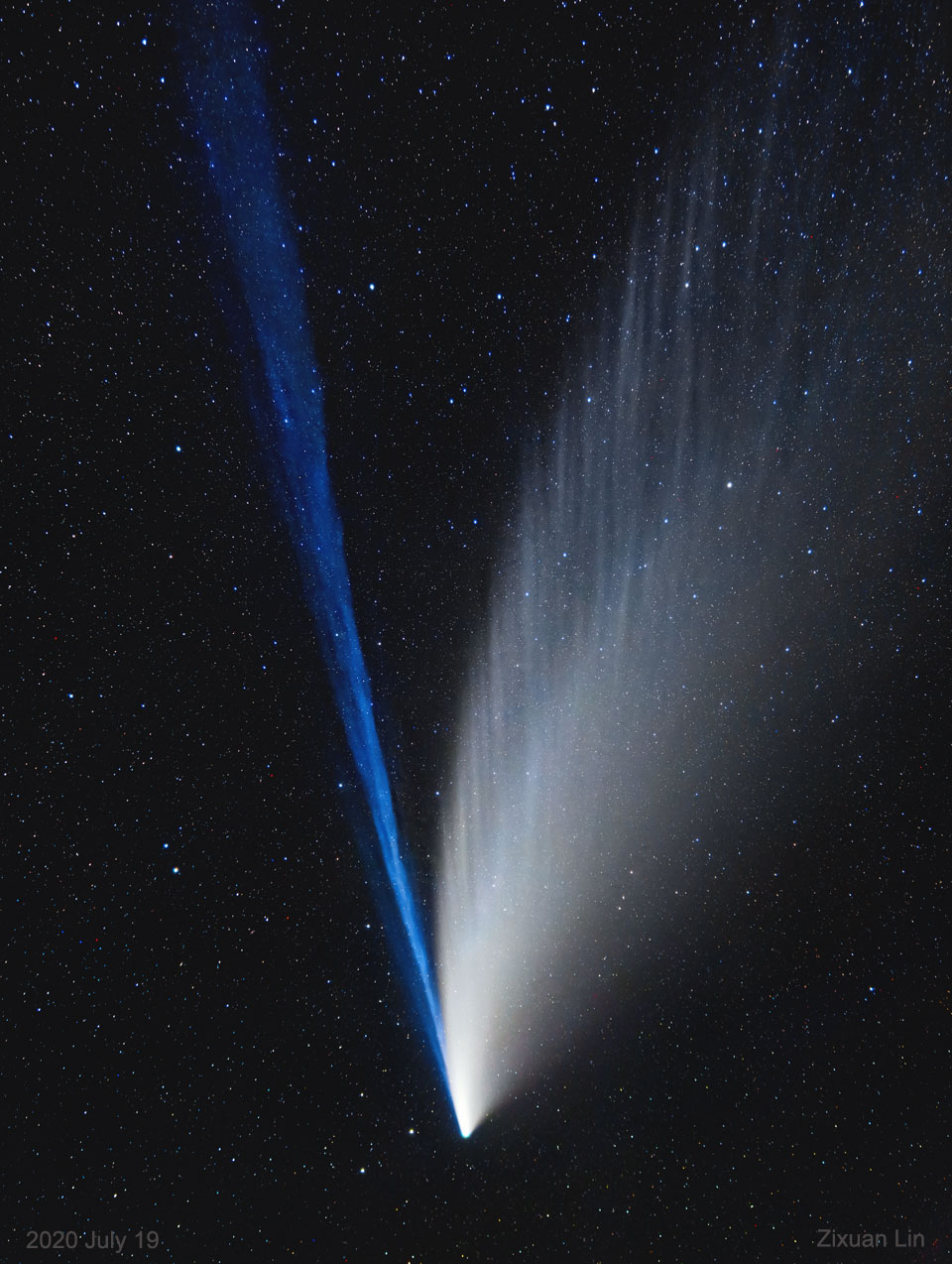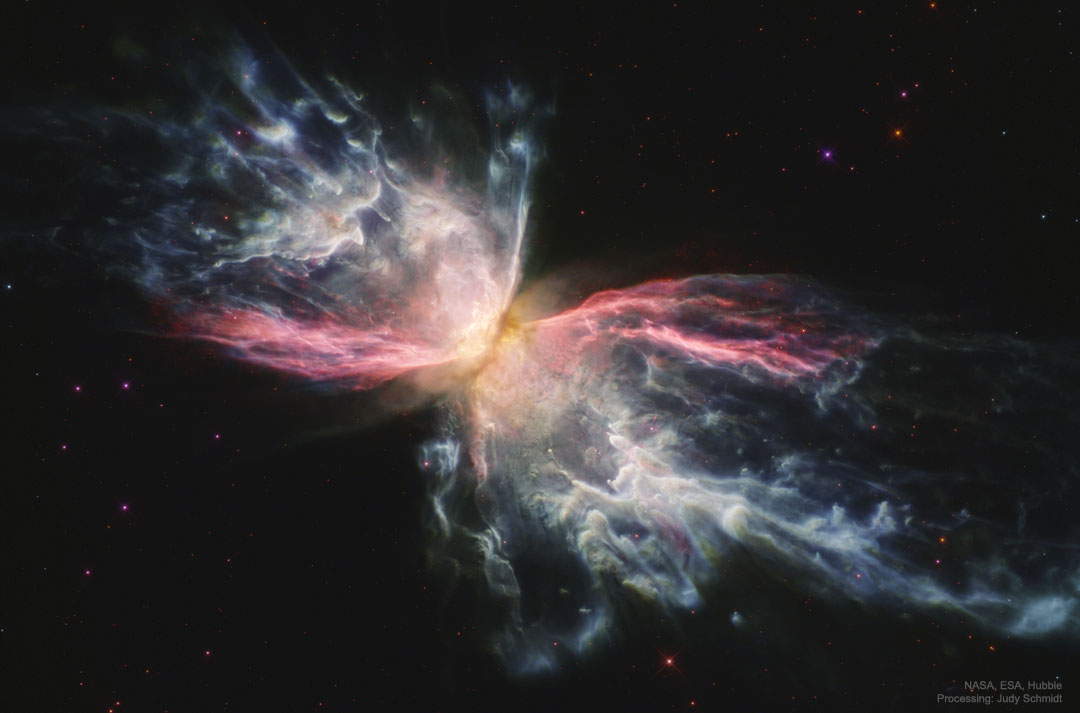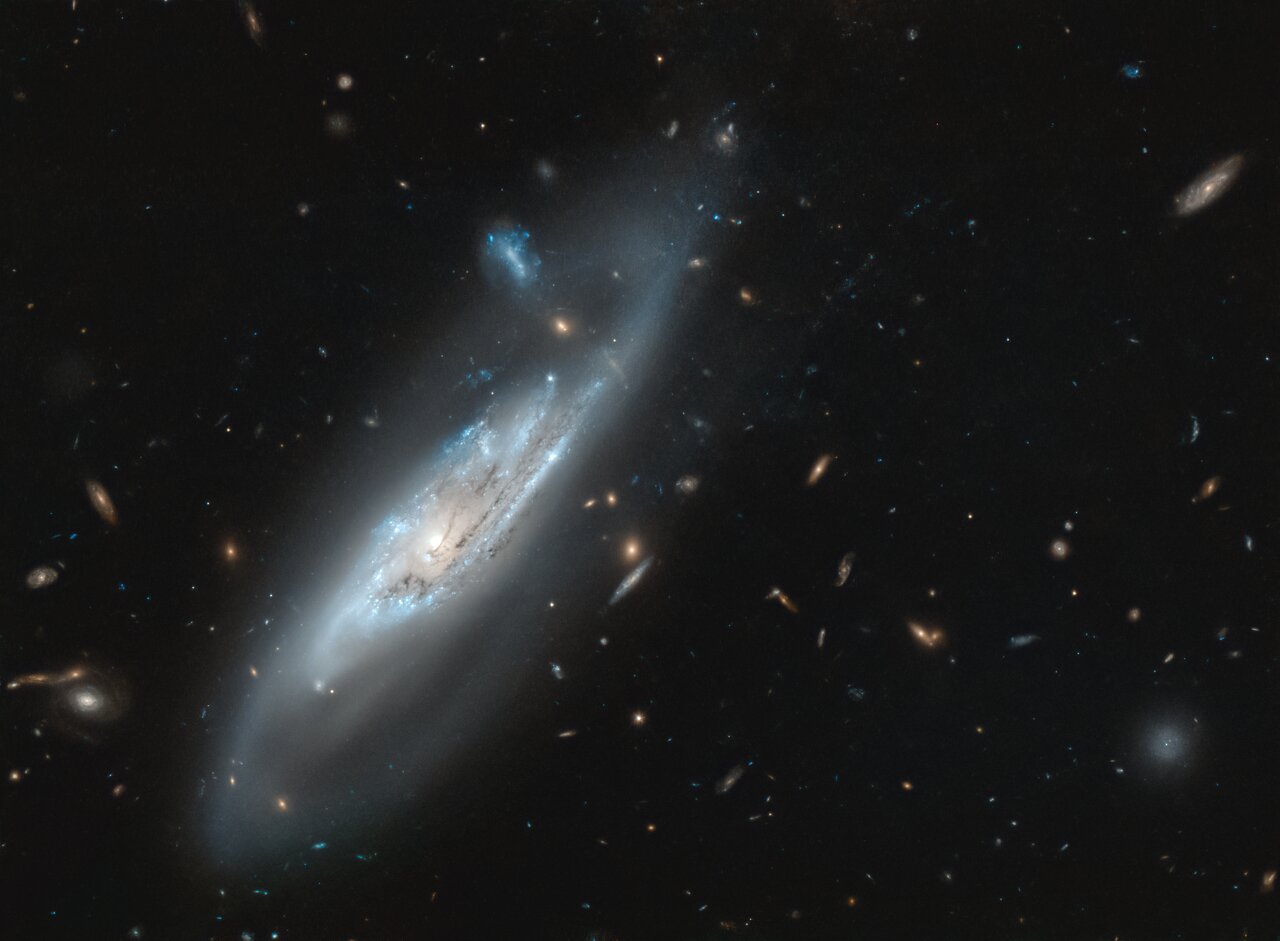Blog
Of the two tails evident, the blue ion tail on the left points directly away from the Sun and is pushed out by the flowing and charged solar wind. Structure in the ion tail comes from different rates of expelled blue-glowing ions from the comet’s nucleus, as well as the always complex and continually changing structure of our Sun’s wind. Most unusual for Comet C/2020 F3 (NEOWISE), though, is the wavy structure of its dust tail. This dust tail is pushed out by sunlight, but curves as heavier dust particles are better able to resist this light pressure and continue along a solar orbit. Comet NEOWISE‘s impressive dust-tail striations are not fully understood, as yet, but likely related to rotating streams of sun-reflecting grit liberated by ice melting on its 5-kilometer wide nucleus. The featured 40-image conglomerate, digitally enhanced, was captured three days ago through the dark skies of the Gobi Desert in Inner Mongolia, China. Comet NEOWISE will make it closest pass to the Earth tomorrow as it moves out from the Sun. The comet, already fading but still visible to the unaided eye, should fade more rapidly as it recedes from the Earth.

Albert Laurence Di Meola (born July 22, 1954) is an American guitarist. Known for his works in jazz fusion and world music, he began his career as a guitarist of the group Return to Forever in 1974. Between the 1970s and 1980s, albums such as Elegant Gypsy and Friday Night in San Franciscoearned him both critical and commercial success.
Born in Jersey City, New Jersey, into an Italian family with roots in Cerreto Sannita, a small town northeast of Benevento, Di Meola grew up in Bergenfield, where he attended Bergenfield High School. He has been a resident of Old Tappan, New Jersey.
When he was eight years old, he was inspired by Elvis Presley and the Ventures to start playing guitar. His teacher directed him toward jazz standards. He cites as influences jazz guitarists George Benson and Kenny Burrell and bluegrass and country guitarists Clarence White and Doc Watson.
He attended Berklee College of Music in the early 1970s. At nineteen, he was hired by Chick Corea to replace Bill Connors in the pioneering jazz fusion band Return to Forever with Stanley Clarke and Lenny White. He recorded three albums with Return to Forever, helping the quartet earn its greatest commercial success as all three albums cracked the Top 40 on the U.S. Billboard pop albums chart. He could play so fast, that he was sometimes criticized for playing too many notes.
more...George Edward Clinton (born July 22, 1941) is an American singer, songwriter, bandleader, and record producer. His Parliament-Funkadeliccollective (which primarily recorded under the distinct band names Parliament and Funkadelic) developed an influential and eclectic form of funk musicduring the 1970s that drew on science fiction, outlandish fashion, psychedelia, and surreal humor. He launched his solo career with the 1982 album Computer Games and would go on to influence 1990s hip-hop and G-funk.
Clinton is regarded, along with James Brown and Sly Stone, as one of the foremost innovators of funk music. He was inducted into the Rock and Roll Hall of Fame in 1997, alongside 15 other members of Parliament-Funkadelic. In 2019, he and Parliament-Funkadelic were given Grammy Lifetime Achievement Awards.
Clinton was born in Kannapolis, North Carolina, United States, grew up in Plainfield, New Jersey, and currently resides in Tallahassee, Florida. During his teen years, Clinton formed a doo-wop group inspired by Frankie Lymon & the Teenagers called The Parliaments, while straightening hair at a barber salon in Plainfield.
more...Don Patterson (July 22, 1936, Columbus, Ohio – February 10, 1988, Philadelphia, Pennsylvania) was an American jazz organist.
Patterson played piano from childhood and was heavily influenced by Erroll Garner in his youth. In 1956, he switched to organ after hearing Jimmy Smith play the instrument. In the early 1960s, he began playing regularly with Sonny Stitt, and he began releasing material as a leader on Prestige Records from 1964 (with Pat Martino and Billy James as sidemen). His most commercially successful album was 1964’s Holiday Soul, which reached #85 on the Billboard 200 in 1967. Patterson’s troubles with drug addiction hobbled his career in the 1970s, during which he occasionally recorded for Muse Records and lived in Gary, Indiana. In the 1980s he moved to Philadelphia and made a small comeback, but his health deteriorated over the course of the decade, and he died there in 1988.
more...Herman “Junior” Cook (July 22, 1934 – February 3, 1992) was an American hard bop tenor saxophone player.
Cook was born in Pensacola, Florida.After playing with Dizzy Gillespie in 1958, Cook gained some fame for his longtime membership in the Horace Silver Quintet (1958–1964); when Silver left the group in the hands of Blue Mitchell Cook stayed in the quintet for five more years (1964–1969). Later associations included Freddie Hubbard, Elvin Jones, George Coleman, Louis Hayes (1975–1976), Bill Hardman (1979–1989), and the McCoy Tynerbig band.
In addition to many appearances as a sideman, Junior Cook recorded as a leader for Jazzland (1961), Catalyst (1977), Muse, and SteepleChase.
He also taught at Berklee School of Music for a year during the 1970s.
In the early 1990s Cook was playing with Clifford Jordan and also leading his own group. He died in his apartment in New York City.
more...https://www.youtube.com/watch?v=2h8EQGnxd4U
more...The Butterfly Nebula. Though its wingspan covers over 3 light-years and its estimated surface temperature exceeds 200,000 degrees, C, the dying central star of NGC 6302, the featured planetary nebula, has become exceptionally hot, shining brightly in visible and ultraviolet light but hidden from direct view by a dense torus of dust. This sharp close-up was recorded by the Hubble Space Telescope and is reprocessed here to show off the remarkable details of the complex planetary nebula, highlighting in particular light emitted by iron, shown in red. NGC 6302 lies about 4,000 light-years away in the arachnologically correct constellation of the Scorpion (Scorpius). Planetary nebulas evolve from outer atmospheres of stars like our Sun, but usually fade in about 20,000 years.

Yusuf Islam (born Steven Demetre Georgiou; 21 July 1948), commonly known by his stage name Cat Stevens, and later Yusuf, is a British singer-songwriter and multi-instrumentalist. His musical style consists of folk, pop, rock, and, in his later career, Islamic music. He was inducted into the Rock and Roll Hall of Fame in 2014.
His 1967 debut album and its title song “Matthew and Son” both reached top ten in the UK charts. Stevens’ albums Tea for the Tillerman (1970) and Teaser and the Firecat (1971) were certified triple platinum in the US. His 1972 album Catch Bull at Four spent weeks at the top of several major charts. He earned ASCAP songwriting awards in 2005 and 2006 for “The First Cut Is the Deepest“, and the song has been a hit for four artists.His other hit songs include “Father and Son“, “Wild World“, “Moonshadow“, “Peace Train“, and “Morning Has Broken“.
In December 1977, Stevens converted to Islam and adopted the name Yusuf Islam the following year. In 1979, he auctioned all of his guitars for charity. He has since bought back at least one of these guitars as a result of the efforts of his son Yoriyos, and left his musical career to devote himself to educational and philanthropic causes in the Muslim community. He was embroiled in a long-running controversy regarding comments he made in 1989 about the death fatwa on author Salman Rushdie. He has received two honorary doctorates and awards for promoting peace as well as other humanitarian awards.
In 2006, he returned to pop music – releasing his first new studio album of new pop songs in 28 years, entitled An Other Cup. With that release and subsequent ones, he dropped the surname “Islam” from the album cover art – using the stage name Yusuf as a mononym. In 2009, he released the album Roadsinger and, in 2014, he released the album Tell ‘Em I’m Gone and began his first US tour since 1978. His second North American tour since his resurgence, featuring 12 shows in intimate venues, ran from 12 September to 7 October 2016. In 2017, he released the album The Laughing Apple.
https://www.youtube.com/watch?v=d34f0ts2PGs
more...Larry McKenna (* 1937 ) is an American jazz – Tenor saxophonist , arranger and music teacher .
more...Conrad Yeatis “Sonny” Clark (July 21, 1931 – January 13, 1963) was an American jazz pianist who mainly worked in the hard bop idiom.
Clark was born and raised in Herminie, Pennsylvania, a coal mining town east of Pittsburgh. His parents were originally from Stone Mountain, Georgia. His miner father, Emery Clark, died of a lung disease two weeks after Sonny was born. Sonny was the youngest of eight children. At age 12, he moved to Pittsburgh.
While visiting an aunt in California at age 20, Clark decided to stay and began working with saxophonist Wardell Gray. Clark went to San Franciscowith Oscar Pettiford and after a couple months, was working with clarinetist Buddy DeFranco in 1953. Clark toured the United States and Europe with DeFranco until January 1956, when he joined The Lighthouse All-Stars, led by bassist Howard Rumsey.
Wishing to return to the east coast, Clark served as accompanist for singer Dinah Washington in February 1957 in order to relocate to New York City. In New York, Clark was often requested as a sideman by many musicians, partly because of his rhythmic comping. He frequently recorded for Blue Note Records as one of their house musicians, playing as a sideman with many hard bop players, including Kenny Burrell, Donald Byrd, Paul Chambers, John Coltrane, Dexter Gordon, Art Farmer, Curtis Fuller, Grant Green, Philly Joe Jones, Clifford Jordan, Jackie McLean, Hank Mobley, Art Taylor, and Wilbur Ware. He also recorded sessions with Charles Mingus, Sonny Rollins, Billie Holiday, Stanley Turrentine, and Lee Morgan.
As a band leader, Clark recorded albums Dial “S” for Sonny (1957, Blue Note), Sonny’s Crib (1957, Blue Note), Sonny Clark Trio (1957, Blue Note), Cool Struttin’ (1958, Blue Note), Blues in the Night (1979, Blue Note), and a second piano trio album titled Sonny Clark Trio (1960, Time Records).
Clark died in New York City on January 13, 1963 (aged 31). The official cause was listed as a heart attack, but the likely cause was a heroin overdose.
more...Floyd Edward “Butter” McDaniel (born July 21, 1915 in Athens (Alabama) , † July 22, 1995 in Chicago ) was an American guitarist and singer in the field of blues , jazz , rhythm & blues and doo-wop .
McDaniel came to Chicago at the age of 15 and began his career in 1933 in the youth band The Rhythm Rascals , which debuted at the Chicago World’s Fair . A talent scout for the Cotton Club discovered him during an appearance at New York’s Apollo Theater , resulting in a longer commitment as head of the Cotton Club Tramp band led; Recordings were made in 1937 with The Tramp Band (with Lester “Pinky” Johnson and Al Cowans). From 1941 to 1954 he played in the Chicago jump blues group The Four Blazes(in changing lineups with Paul Lindsley “Jelly” Holt, Tommy Braden, Ernie Harper, William “Shorty” Hill, later as Five Blazers ), who also acted as Sam Cooke’sbacking band in the late 1950s . The Four Blazes successfully released several 78s on Aristocrat ( Chicago Boogie , 1947) and United Artists Records such as Night Train / Rug Cutter , Perfect Woman, Please Send Her Back to Me, Mary Jo (# 1 of the R&B charts 1952), All Night Long and Please Send Her Back to Me / Stop Boogie Woogie (1952) or as Five Blazesthe single Chicago Boogie / Dedicated to You. After the dissolution of the Five Blazes bought McDaniels a bar in Chicago.
In the following decade, McDaniel belonged to a rock band; In the 1970s, he appeared as a guitarist with one of the revival groups known as Ink Spots . In the 1980s, he played with Willie Dixon in the Big Three Trio . Recordings were made in 1991 for Delmark Records with the band The Blues Swingers , led by tenor saxophonist Dave Clark, stylistically based on the blues and rhythm & blues of the 40s ( Let Your Hair Down ! , Delmark). Shortly before his death occurred Floyd McDaniel 1994 at the Bremen Blue Festival Breminale on. He died of a heart attack on the Dan Ryan Expressway one day after his eightieth birthday .
more...
A notable feature of most spiral galaxies is the multitude of arching spiral arms that seemingly spin out from the galaxy’s centre. In this image, taken with the NASA/ESA Hubble Space Telescope, the stunning silvery-blue spiral arms of the galaxy NGC 4848 are observed in immense detail. Not only do we see the inner section of the spiral arms containing hundreds of thousands of young, bright, blue stars, but Hubble has also captured the extremely faint wispy tails of the outer spiral arms.
This wispy barred spiral galaxy was first discovered in 1865 by the German astronomer Heinrich Louis d’Arrest. In his career, Heinrich also notably discovered the asteroid 76 Freia and many other galaxies and he also contributed to the discovery of Neptune.
If you are situated in the Northern Hemisphere with a large telescope, you might just be able to observe the ghost-like appearance of this faint galaxy within faint constellation of Coma Berenices (Berenice’s Hair).

More Posts
- World Music with Nico Kasanda
- Daily Roots with Hortense Ellis
- The Cosmos with M24
- Gilberto Gil Day
- Julian Priester Day
- World Music with Paco De Lucia
- Daily Roots with Alton Ellis & the Heptones
- The Cosmos with Sharpless 2-106
- John Medeski Day
- David Honeyboy Edwards Day
- World Music with Odpoczno
- Daily Roots with Ras Tweed
- The Cosmos with M8
- Johnny “Big Moose” Walker Day
- Elmo Hope Day
- Shad Collins Day
- World Music with Eleftheria Arvanitaki
- Daily Roots with Israel Vibration
- The Cosmos with NGC 1187
- Reggie Workman Day